BFA605 Case Study: Human Capital Asset Recognition Analysis
VerifiedAdded on 2022/10/10
|8
|2068
|195
Case Study
AI Summary
This case study delves into the contentious issue of recognizing human capital as a financial asset. The assignment presents arguments both for and against this recognition, supported by relevant case studies, accounting standards (specifically from Australia), and interpretations of the Conceptual Framework. It explores the traditional view of human capital as an intangible asset, contrasting it with arguments for its inclusion on the balance sheet, considering its economic value derived from employee skills and experience. The case study examines the challenges of classifying human capital (current vs. fixed asset, depreciation), and explores alternative recognition methods such as Human Resource Accounting. It also discusses the Human Capital Theory, the limitations of this approach, and the impact of tax laws. The conclusion emphasizes the importance of human capital while acknowledging the limitations and challenges, advocating for its consideration as a valuable organizational asset.
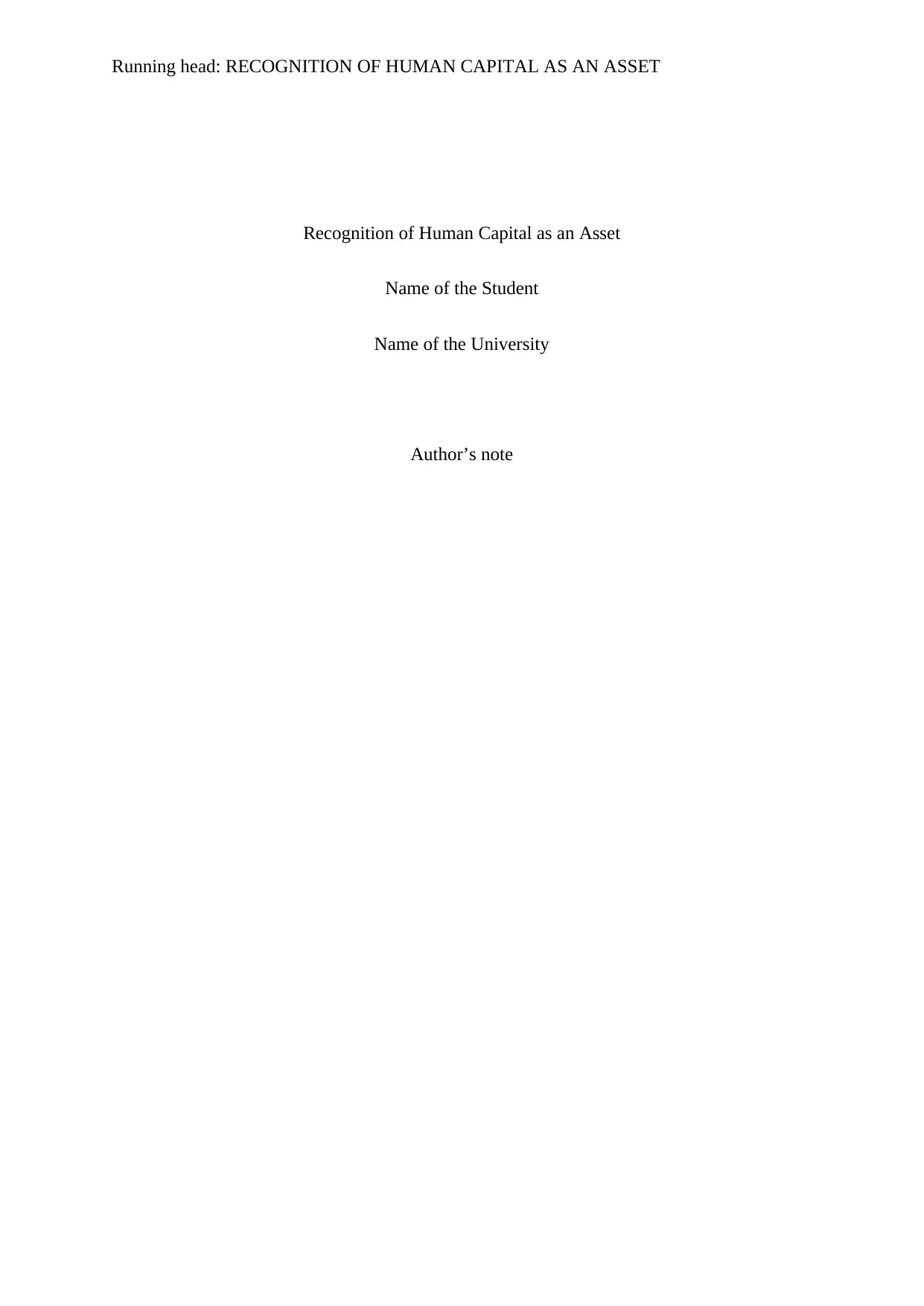
Running head: RECOGNITION OF HUMAN CAPITAL AS AN ASSET
Recognition of Human Capital as an Asset
Name of the Student
Name of the University
Author’s note
Recognition of Human Capital as an Asset
Name of the Student
Name of the University
Author’s note
Paraphrase This Document
Need a fresh take? Get an instant paraphrase of this document with our AI Paraphraser
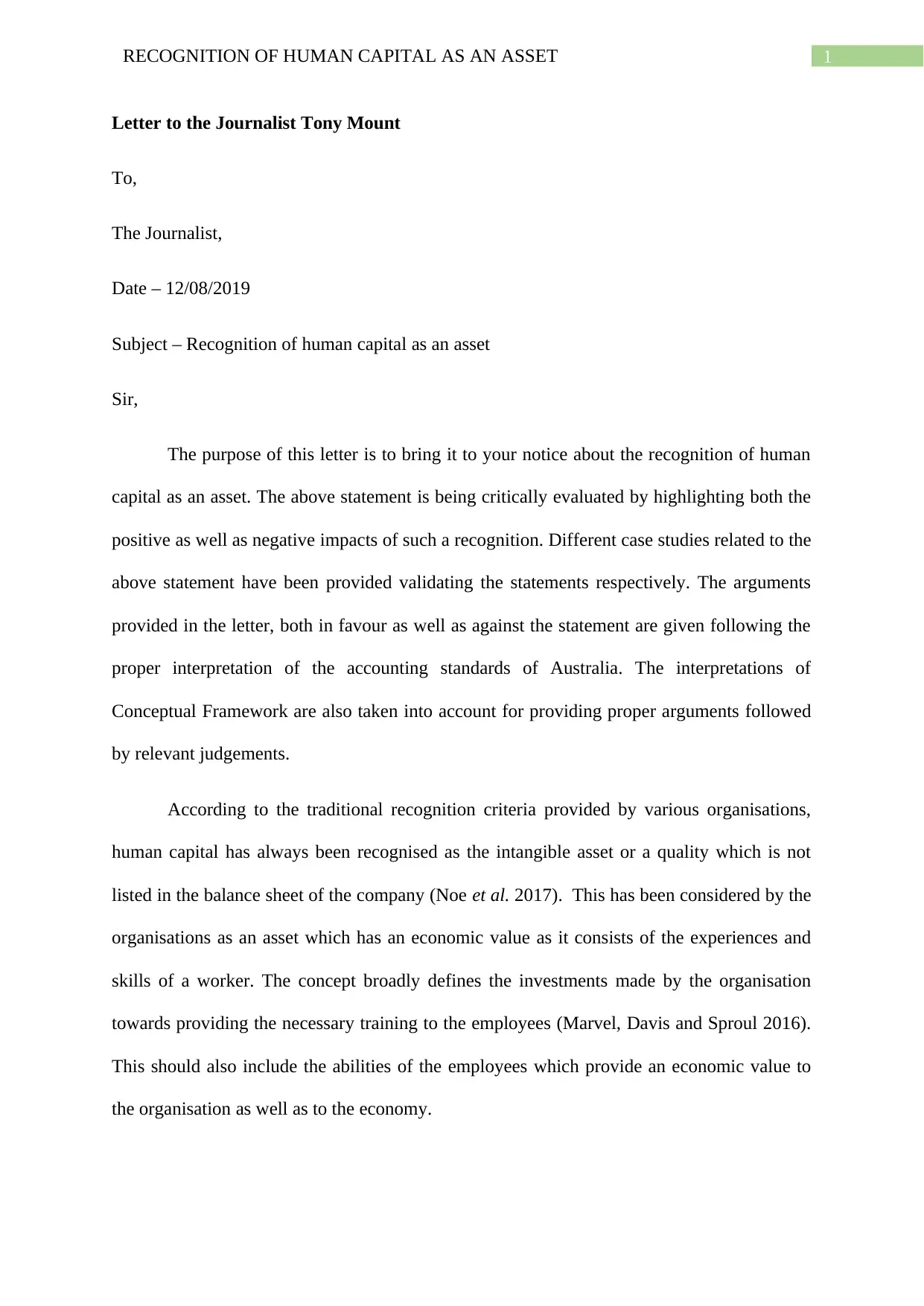
1RECOGNITION OF HUMAN CAPITAL AS AN ASSET
Letter to the Journalist Tony Mount
To,
The Journalist,
Date – 12/08/2019
Subject – Recognition of human capital as an asset
Sir,
The purpose of this letter is to bring it to your notice about the recognition of human
capital as an asset. The above statement is being critically evaluated by highlighting both the
positive as well as negative impacts of such a recognition. Different case studies related to the
above statement have been provided validating the statements respectively. The arguments
provided in the letter, both in favour as well as against the statement are given following the
proper interpretation of the accounting standards of Australia. The interpretations of
Conceptual Framework are also taken into account for providing proper arguments followed
by relevant judgements.
According to the traditional recognition criteria provided by various organisations,
human capital has always been recognised as the intangible asset or a quality which is not
listed in the balance sheet of the company (Noe et al. 2017). This has been considered by the
organisations as an asset which has an economic value as it consists of the experiences and
skills of a worker. The concept broadly defines the investments made by the organisation
towards providing the necessary training to the employees (Marvel, Davis and Sproul 2016).
This should also include the abilities of the employees which provide an economic value to
the organisation as well as to the economy.
Letter to the Journalist Tony Mount
To,
The Journalist,
Date – 12/08/2019
Subject – Recognition of human capital as an asset
Sir,
The purpose of this letter is to bring it to your notice about the recognition of human
capital as an asset. The above statement is being critically evaluated by highlighting both the
positive as well as negative impacts of such a recognition. Different case studies related to the
above statement have been provided validating the statements respectively. The arguments
provided in the letter, both in favour as well as against the statement are given following the
proper interpretation of the accounting standards of Australia. The interpretations of
Conceptual Framework are also taken into account for providing proper arguments followed
by relevant judgements.
According to the traditional recognition criteria provided by various organisations,
human capital has always been recognised as the intangible asset or a quality which is not
listed in the balance sheet of the company (Noe et al. 2017). This has been considered by the
organisations as an asset which has an economic value as it consists of the experiences and
skills of a worker. The concept broadly defines the investments made by the organisation
towards providing the necessary training to the employees (Marvel, Davis and Sproul 2016).
This should also include the abilities of the employees which provide an economic value to
the organisation as well as to the economy.
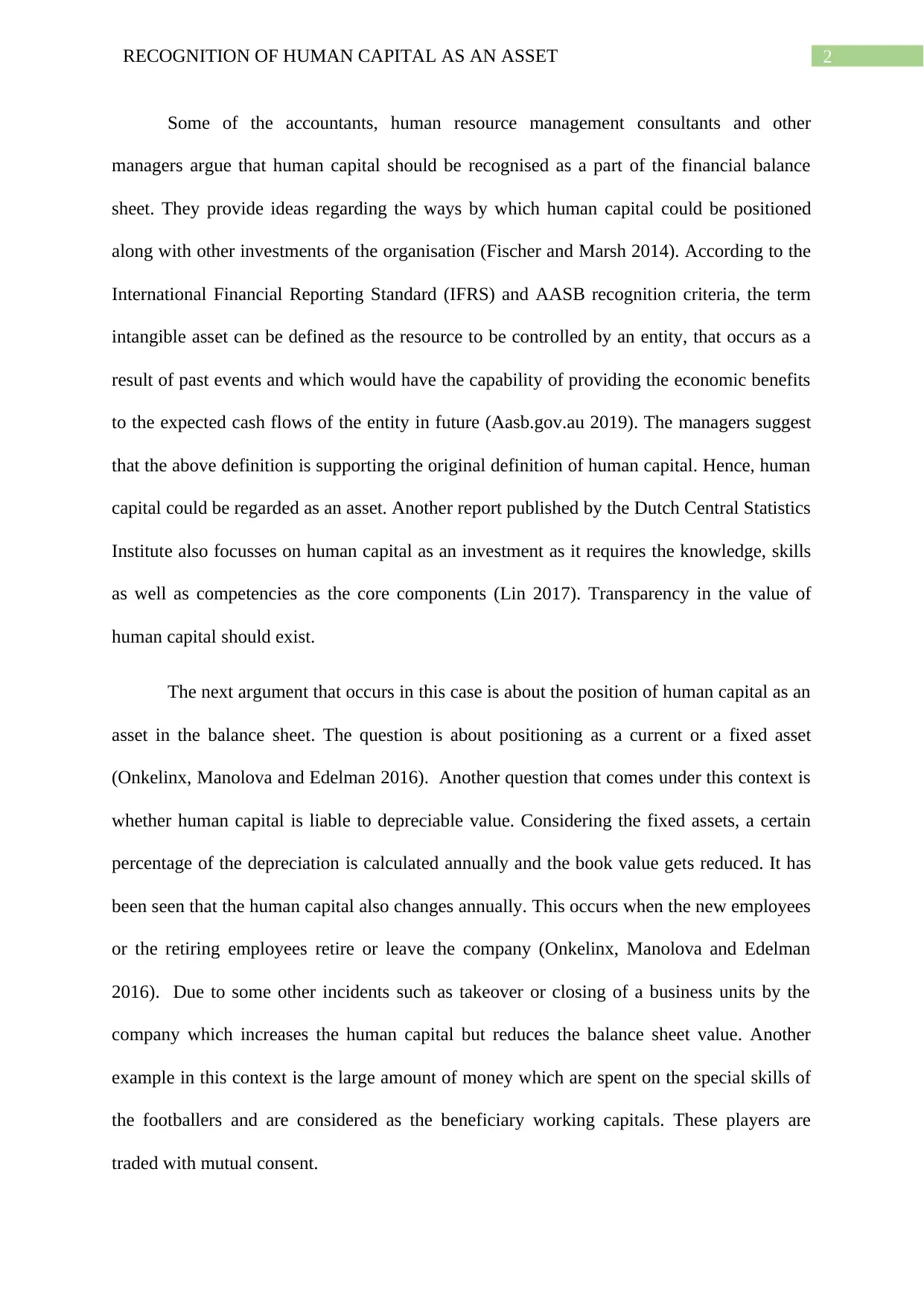
2RECOGNITION OF HUMAN CAPITAL AS AN ASSET
Some of the accountants, human resource management consultants and other
managers argue that human capital should be recognised as a part of the financial balance
sheet. They provide ideas regarding the ways by which human capital could be positioned
along with other investments of the organisation (Fischer and Marsh 2014). According to the
International Financial Reporting Standard (IFRS) and AASB recognition criteria, the term
intangible asset can be defined as the resource to be controlled by an entity, that occurs as a
result of past events and which would have the capability of providing the economic benefits
to the expected cash flows of the entity in future (Aasb.gov.au 2019). The managers suggest
that the above definition is supporting the original definition of human capital. Hence, human
capital could be regarded as an asset. Another report published by the Dutch Central Statistics
Institute also focusses on human capital as an investment as it requires the knowledge, skills
as well as competencies as the core components (Lin 2017). Transparency in the value of
human capital should exist.
The next argument that occurs in this case is about the position of human capital as an
asset in the balance sheet. The question is about positioning as a current or a fixed asset
(Onkelinx, Manolova and Edelman 2016). Another question that comes under this context is
whether human capital is liable to depreciable value. Considering the fixed assets, a certain
percentage of the depreciation is calculated annually and the book value gets reduced. It has
been seen that the human capital also changes annually. This occurs when the new employees
or the retiring employees retire or leave the company (Onkelinx, Manolova and Edelman
2016). Due to some other incidents such as takeover or closing of a business units by the
company which increases the human capital but reduces the balance sheet value. Another
example in this context is the large amount of money which are spent on the special skills of
the footballers and are considered as the beneficiary working capitals. These players are
traded with mutual consent.
Some of the accountants, human resource management consultants and other
managers argue that human capital should be recognised as a part of the financial balance
sheet. They provide ideas regarding the ways by which human capital could be positioned
along with other investments of the organisation (Fischer and Marsh 2014). According to the
International Financial Reporting Standard (IFRS) and AASB recognition criteria, the term
intangible asset can be defined as the resource to be controlled by an entity, that occurs as a
result of past events and which would have the capability of providing the economic benefits
to the expected cash flows of the entity in future (Aasb.gov.au 2019). The managers suggest
that the above definition is supporting the original definition of human capital. Hence, human
capital could be regarded as an asset. Another report published by the Dutch Central Statistics
Institute also focusses on human capital as an investment as it requires the knowledge, skills
as well as competencies as the core components (Lin 2017). Transparency in the value of
human capital should exist.
The next argument that occurs in this case is about the position of human capital as an
asset in the balance sheet. The question is about positioning as a current or a fixed asset
(Onkelinx, Manolova and Edelman 2016). Another question that comes under this context is
whether human capital is liable to depreciable value. Considering the fixed assets, a certain
percentage of the depreciation is calculated annually and the book value gets reduced. It has
been seen that the human capital also changes annually. This occurs when the new employees
or the retiring employees retire or leave the company (Onkelinx, Manolova and Edelman
2016). Due to some other incidents such as takeover or closing of a business units by the
company which increases the human capital but reduces the balance sheet value. Another
example in this context is the large amount of money which are spent on the special skills of
the footballers and are considered as the beneficiary working capitals. These players are
traded with mutual consent.
⊘ This is a preview!⊘
Do you want full access?
Subscribe today to unlock all pages.

Trusted by 1+ million students worldwide
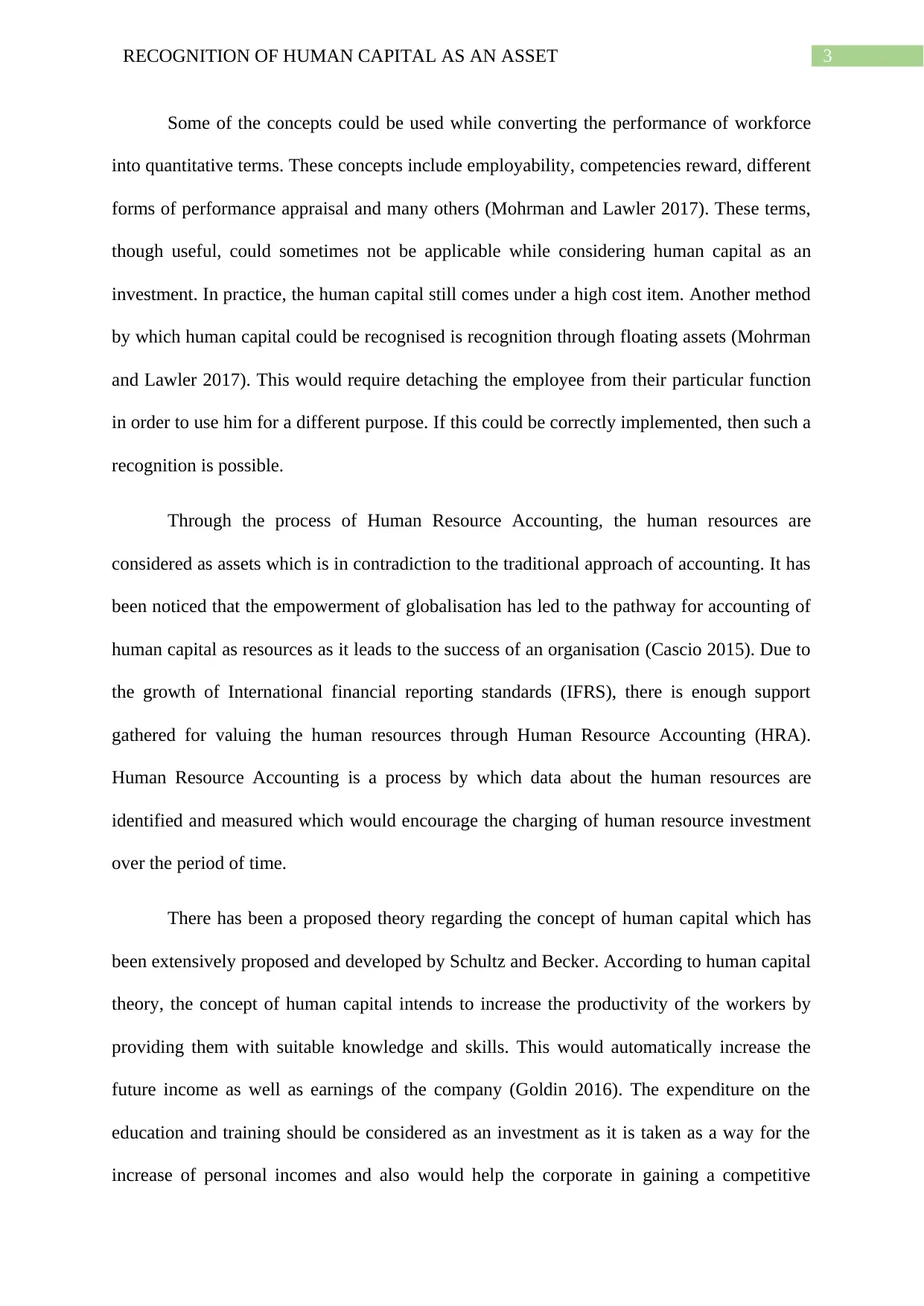
3RECOGNITION OF HUMAN CAPITAL AS AN ASSET
Some of the concepts could be used while converting the performance of workforce
into quantitative terms. These concepts include employability, competencies reward, different
forms of performance appraisal and many others (Mohrman and Lawler 2017). These terms,
though useful, could sometimes not be applicable while considering human capital as an
investment. In practice, the human capital still comes under a high cost item. Another method
by which human capital could be recognised is recognition through floating assets (Mohrman
and Lawler 2017). This would require detaching the employee from their particular function
in order to use him for a different purpose. If this could be correctly implemented, then such a
recognition is possible.
Through the process of Human Resource Accounting, the human resources are
considered as assets which is in contradiction to the traditional approach of accounting. It has
been noticed that the empowerment of globalisation has led to the pathway for accounting of
human capital as resources as it leads to the success of an organisation (Cascio 2015). Due to
the growth of International financial reporting standards (IFRS), there is enough support
gathered for valuing the human resources through Human Resource Accounting (HRA).
Human Resource Accounting is a process by which data about the human resources are
identified and measured which would encourage the charging of human resource investment
over the period of time.
There has been a proposed theory regarding the concept of human capital which has
been extensively proposed and developed by Schultz and Becker. According to human capital
theory, the concept of human capital intends to increase the productivity of the workers by
providing them with suitable knowledge and skills. This would automatically increase the
future income as well as earnings of the company (Goldin 2016). The expenditure on the
education and training should be considered as an investment as it is taken as a way for the
increase of personal incomes and also would help the corporate in gaining a competitive
Some of the concepts could be used while converting the performance of workforce
into quantitative terms. These concepts include employability, competencies reward, different
forms of performance appraisal and many others (Mohrman and Lawler 2017). These terms,
though useful, could sometimes not be applicable while considering human capital as an
investment. In practice, the human capital still comes under a high cost item. Another method
by which human capital could be recognised is recognition through floating assets (Mohrman
and Lawler 2017). This would require detaching the employee from their particular function
in order to use him for a different purpose. If this could be correctly implemented, then such a
recognition is possible.
Through the process of Human Resource Accounting, the human resources are
considered as assets which is in contradiction to the traditional approach of accounting. It has
been noticed that the empowerment of globalisation has led to the pathway for accounting of
human capital as resources as it leads to the success of an organisation (Cascio 2015). Due to
the growth of International financial reporting standards (IFRS), there is enough support
gathered for valuing the human resources through Human Resource Accounting (HRA).
Human Resource Accounting is a process by which data about the human resources are
identified and measured which would encourage the charging of human resource investment
over the period of time.
There has been a proposed theory regarding the concept of human capital which has
been extensively proposed and developed by Schultz and Becker. According to human capital
theory, the concept of human capital intends to increase the productivity of the workers by
providing them with suitable knowledge and skills. This would automatically increase the
future income as well as earnings of the company (Goldin 2016). The expenditure on the
education and training should be considered as an investment as it is taken as a way for the
increase of personal incomes and also would help the corporate in gaining a competitive
Paraphrase This Document
Need a fresh take? Get an instant paraphrase of this document with our AI Paraphraser
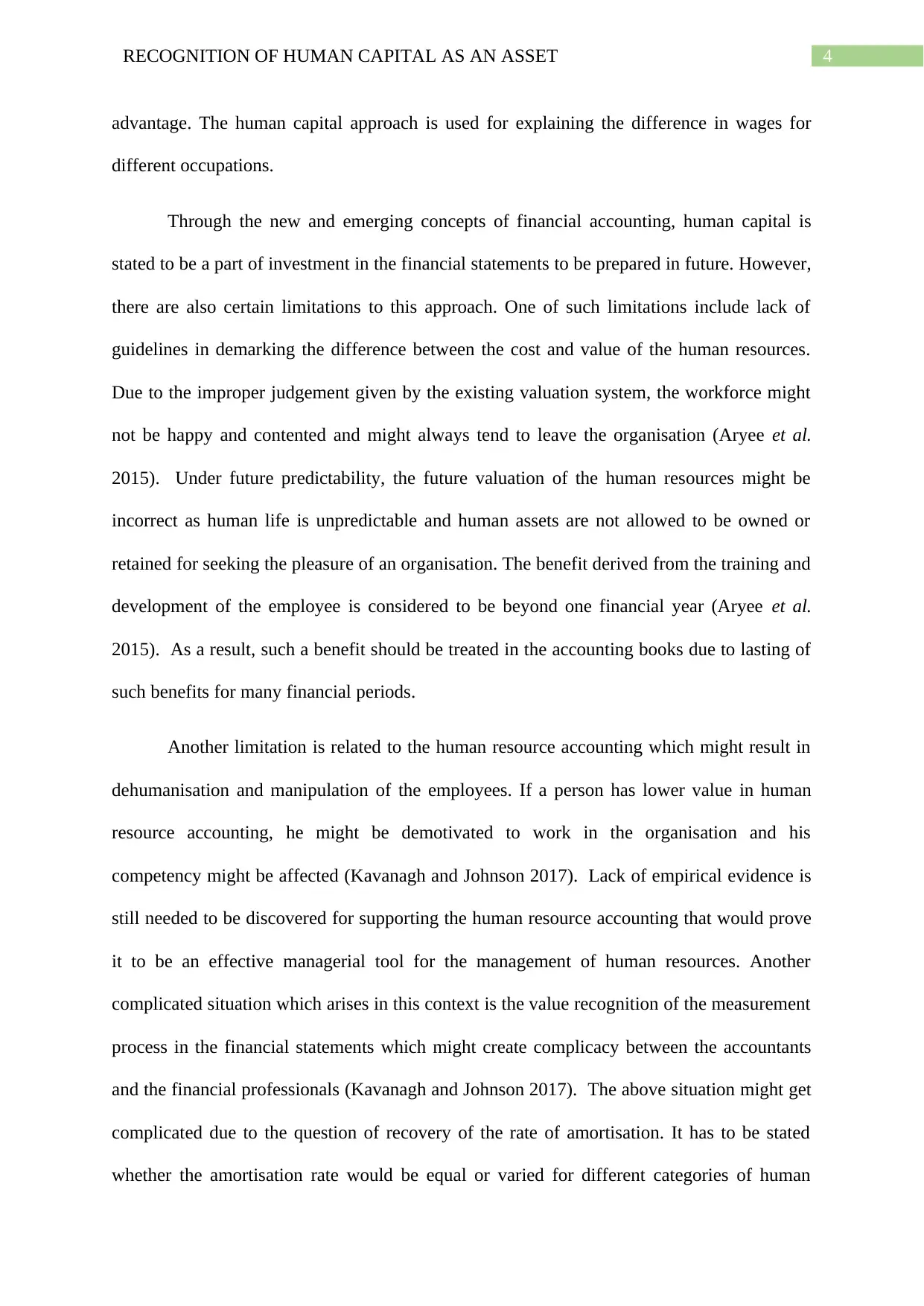
4RECOGNITION OF HUMAN CAPITAL AS AN ASSET
advantage. The human capital approach is used for explaining the difference in wages for
different occupations.
Through the new and emerging concepts of financial accounting, human capital is
stated to be a part of investment in the financial statements to be prepared in future. However,
there are also certain limitations to this approach. One of such limitations include lack of
guidelines in demarking the difference between the cost and value of the human resources.
Due to the improper judgement given by the existing valuation system, the workforce might
not be happy and contented and might always tend to leave the organisation (Aryee et al.
2015). Under future predictability, the future valuation of the human resources might be
incorrect as human life is unpredictable and human assets are not allowed to be owned or
retained for seeking the pleasure of an organisation. The benefit derived from the training and
development of the employee is considered to be beyond one financial year (Aryee et al.
2015). As a result, such a benefit should be treated in the accounting books due to lasting of
such benefits for many financial periods.
Another limitation is related to the human resource accounting which might result in
dehumanisation and manipulation of the employees. If a person has lower value in human
resource accounting, he might be demotivated to work in the organisation and his
competency might be affected (Kavanagh and Johnson 2017). Lack of empirical evidence is
still needed to be discovered for supporting the human resource accounting that would prove
it to be an effective managerial tool for the management of human resources. Another
complicated situation which arises in this context is the value recognition of the measurement
process in the financial statements which might create complicacy between the accountants
and the financial professionals (Kavanagh and Johnson 2017). The above situation might get
complicated due to the question of recovery of the rate of amortisation. It has to be stated
whether the amortisation rate would be equal or varied for different categories of human
advantage. The human capital approach is used for explaining the difference in wages for
different occupations.
Through the new and emerging concepts of financial accounting, human capital is
stated to be a part of investment in the financial statements to be prepared in future. However,
there are also certain limitations to this approach. One of such limitations include lack of
guidelines in demarking the difference between the cost and value of the human resources.
Due to the improper judgement given by the existing valuation system, the workforce might
not be happy and contented and might always tend to leave the organisation (Aryee et al.
2015). Under future predictability, the future valuation of the human resources might be
incorrect as human life is unpredictable and human assets are not allowed to be owned or
retained for seeking the pleasure of an organisation. The benefit derived from the training and
development of the employee is considered to be beyond one financial year (Aryee et al.
2015). As a result, such a benefit should be treated in the accounting books due to lasting of
such benefits for many financial periods.
Another limitation is related to the human resource accounting which might result in
dehumanisation and manipulation of the employees. If a person has lower value in human
resource accounting, he might be demotivated to work in the organisation and his
competency might be affected (Kavanagh and Johnson 2017). Lack of empirical evidence is
still needed to be discovered for supporting the human resource accounting that would prove
it to be an effective managerial tool for the management of human resources. Another
complicated situation which arises in this context is the value recognition of the measurement
process in the financial statements which might create complicacy between the accountants
and the financial professionals (Kavanagh and Johnson 2017). The above situation might get
complicated due to the question of recovery of the rate of amortisation. It has to be stated
whether the amortisation rate would be equal or varied for different categories of human
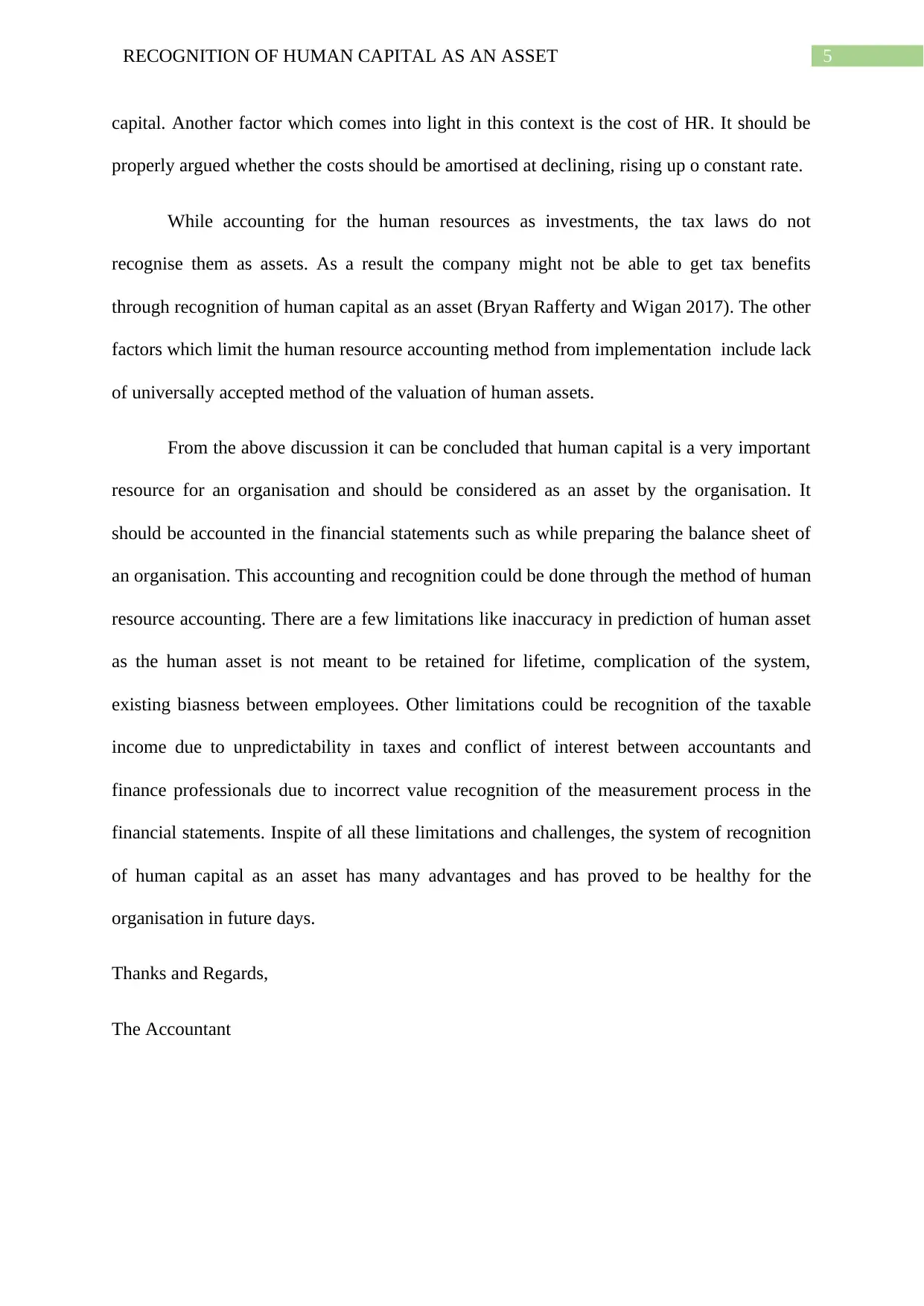
5RECOGNITION OF HUMAN CAPITAL AS AN ASSET
capital. Another factor which comes into light in this context is the cost of HR. It should be
properly argued whether the costs should be amortised at declining, rising up o constant rate.
While accounting for the human resources as investments, the tax laws do not
recognise them as assets. As a result the company might not be able to get tax benefits
through recognition of human capital as an asset (Bryan Rafferty and Wigan 2017). The other
factors which limit the human resource accounting method from implementation include lack
of universally accepted method of the valuation of human assets.
From the above discussion it can be concluded that human capital is a very important
resource for an organisation and should be considered as an asset by the organisation. It
should be accounted in the financial statements such as while preparing the balance sheet of
an organisation. This accounting and recognition could be done through the method of human
resource accounting. There are a few limitations like inaccuracy in prediction of human asset
as the human asset is not meant to be retained for lifetime, complication of the system,
existing biasness between employees. Other limitations could be recognition of the taxable
income due to unpredictability in taxes and conflict of interest between accountants and
finance professionals due to incorrect value recognition of the measurement process in the
financial statements. Inspite of all these limitations and challenges, the system of recognition
of human capital as an asset has many advantages and has proved to be healthy for the
organisation in future days.
Thanks and Regards,
The Accountant
capital. Another factor which comes into light in this context is the cost of HR. It should be
properly argued whether the costs should be amortised at declining, rising up o constant rate.
While accounting for the human resources as investments, the tax laws do not
recognise them as assets. As a result the company might not be able to get tax benefits
through recognition of human capital as an asset (Bryan Rafferty and Wigan 2017). The other
factors which limit the human resource accounting method from implementation include lack
of universally accepted method of the valuation of human assets.
From the above discussion it can be concluded that human capital is a very important
resource for an organisation and should be considered as an asset by the organisation. It
should be accounted in the financial statements such as while preparing the balance sheet of
an organisation. This accounting and recognition could be done through the method of human
resource accounting. There are a few limitations like inaccuracy in prediction of human asset
as the human asset is not meant to be retained for lifetime, complication of the system,
existing biasness between employees. Other limitations could be recognition of the taxable
income due to unpredictability in taxes and conflict of interest between accountants and
finance professionals due to incorrect value recognition of the measurement process in the
financial statements. Inspite of all these limitations and challenges, the system of recognition
of human capital as an asset has many advantages and has proved to be healthy for the
organisation in future days.
Thanks and Regards,
The Accountant
⊘ This is a preview!⊘
Do you want full access?
Subscribe today to unlock all pages.

Trusted by 1+ million students worldwide
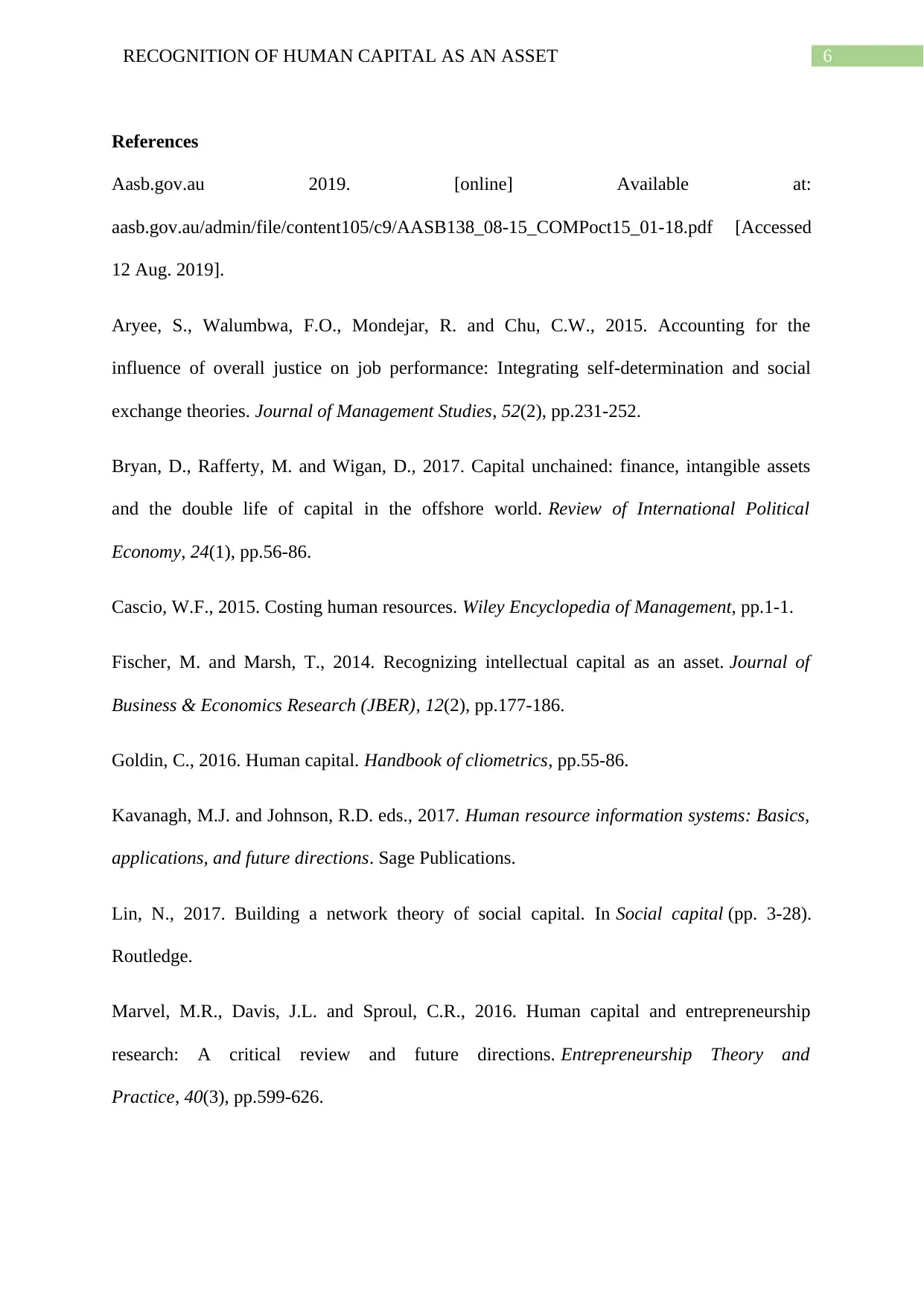
6RECOGNITION OF HUMAN CAPITAL AS AN ASSET
References
Aasb.gov.au 2019. [online] Available at:
aasb.gov.au/admin/file/content105/c9/AASB138_08-15_COMPoct15_01-18.pdf [Accessed
12 Aug. 2019].
Aryee, S., Walumbwa, F.O., Mondejar, R. and Chu, C.W., 2015. Accounting for the
influence of overall justice on job performance: Integrating self‐determination and social
exchange theories. Journal of Management Studies, 52(2), pp.231-252.
Bryan, D., Rafferty, M. and Wigan, D., 2017. Capital unchained: finance, intangible assets
and the double life of capital in the offshore world. Review of International Political
Economy, 24(1), pp.56-86.
Cascio, W.F., 2015. Costing human resources. Wiley Encyclopedia of Management, pp.1-1.
Fischer, M. and Marsh, T., 2014. Recognizing intellectual capital as an asset. Journal of
Business & Economics Research (JBER), 12(2), pp.177-186.
Goldin, C., 2016. Human capital. Handbook of cliometrics, pp.55-86.
Kavanagh, M.J. and Johnson, R.D. eds., 2017. Human resource information systems: Basics,
applications, and future directions. Sage Publications.
Lin, N., 2017. Building a network theory of social capital. In Social capital (pp. 3-28).
Routledge.
Marvel, M.R., Davis, J.L. and Sproul, C.R., 2016. Human capital and entrepreneurship
research: A critical review and future directions. Entrepreneurship Theory and
Practice, 40(3), pp.599-626.
References
Aasb.gov.au 2019. [online] Available at:
aasb.gov.au/admin/file/content105/c9/AASB138_08-15_COMPoct15_01-18.pdf [Accessed
12 Aug. 2019].
Aryee, S., Walumbwa, F.O., Mondejar, R. and Chu, C.W., 2015. Accounting for the
influence of overall justice on job performance: Integrating self‐determination and social
exchange theories. Journal of Management Studies, 52(2), pp.231-252.
Bryan, D., Rafferty, M. and Wigan, D., 2017. Capital unchained: finance, intangible assets
and the double life of capital in the offshore world. Review of International Political
Economy, 24(1), pp.56-86.
Cascio, W.F., 2015. Costing human resources. Wiley Encyclopedia of Management, pp.1-1.
Fischer, M. and Marsh, T., 2014. Recognizing intellectual capital as an asset. Journal of
Business & Economics Research (JBER), 12(2), pp.177-186.
Goldin, C., 2016. Human capital. Handbook of cliometrics, pp.55-86.
Kavanagh, M.J. and Johnson, R.D. eds., 2017. Human resource information systems: Basics,
applications, and future directions. Sage Publications.
Lin, N., 2017. Building a network theory of social capital. In Social capital (pp. 3-28).
Routledge.
Marvel, M.R., Davis, J.L. and Sproul, C.R., 2016. Human capital and entrepreneurship
research: A critical review and future directions. Entrepreneurship Theory and
Practice, 40(3), pp.599-626.
Paraphrase This Document
Need a fresh take? Get an instant paraphrase of this document with our AI Paraphraser
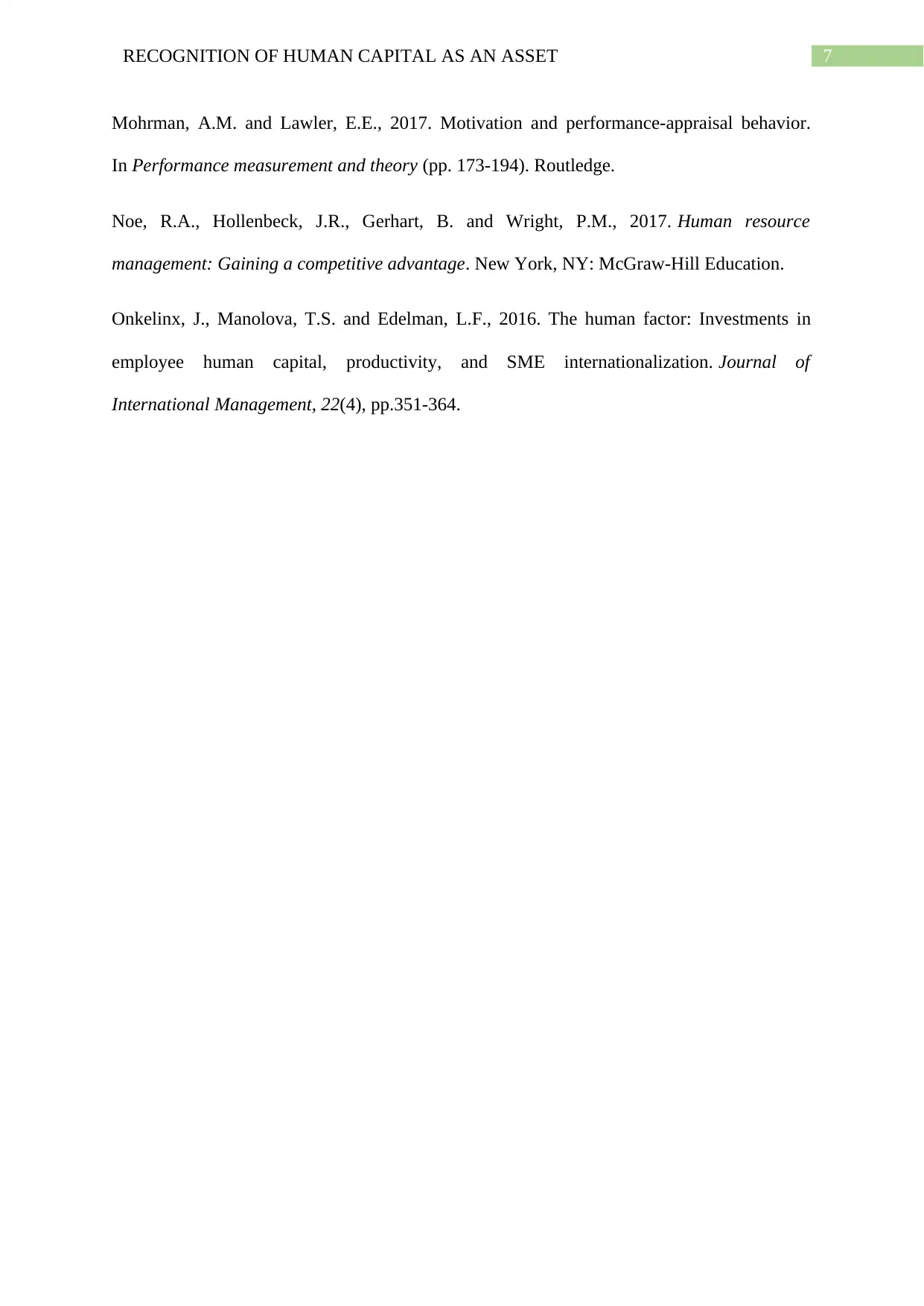
7RECOGNITION OF HUMAN CAPITAL AS AN ASSET
Mohrman, A.M. and Lawler, E.E., 2017. Motivation and performance-appraisal behavior.
In Performance measurement and theory (pp. 173-194). Routledge.
Noe, R.A., Hollenbeck, J.R., Gerhart, B. and Wright, P.M., 2017. Human resource
management: Gaining a competitive advantage. New York, NY: McGraw-Hill Education.
Onkelinx, J., Manolova, T.S. and Edelman, L.F., 2016. The human factor: Investments in
employee human capital, productivity, and SME internationalization. Journal of
International Management, 22(4), pp.351-364.
Mohrman, A.M. and Lawler, E.E., 2017. Motivation and performance-appraisal behavior.
In Performance measurement and theory (pp. 173-194). Routledge.
Noe, R.A., Hollenbeck, J.R., Gerhart, B. and Wright, P.M., 2017. Human resource
management: Gaining a competitive advantage. New York, NY: McGraw-Hill Education.
Onkelinx, J., Manolova, T.S. and Edelman, L.F., 2016. The human factor: Investments in
employee human capital, productivity, and SME internationalization. Journal of
International Management, 22(4), pp.351-364.
1 out of 8
Related Documents
Your All-in-One AI-Powered Toolkit for Academic Success.
+13062052269
info@desklib.com
Available 24*7 on WhatsApp / Email
![[object Object]](/_next/static/media/star-bottom.7253800d.svg)
Unlock your academic potential
Copyright © 2020–2025 A2Z Services. All Rights Reserved. Developed and managed by ZUCOL.





